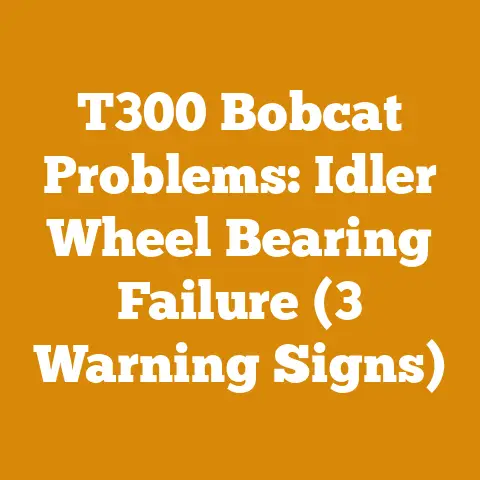Chainsaw Safety Chain Benefits (5 Expert Tips for Woodworkers)
Let’s embrace the beauty of wood processing and firewood preparation with a conscience, championing eco-friendly practices that honor our forests and ensure their vitality for generations to come.
Chainsaw Safety Chain Benefits: 5 Expert Tips for Woodworkers
As a woodworker for over 20 years, I’ve learned a thing or two about staying safe around chainsaws. It’s not just about having the right equipment; it’s about understanding how each part works together to protect you. Today, I want to share my knowledge on chainsaw safety chains, specifically, and how they can significantly improve your safety. Trust me, these aren’t just marketing gimmicks; they’re real lifesavers.
The global logging and firewood industry is massive, with a market value that’s consistently growing. According to recent reports, the global firewood market alone is projected to reach billions of dollars in the next few years. This demand underscores the importance of safe and efficient wood processing, especially given the inherent risks involved. Safety chains are a critical component in mitigating these risks, making them essential for both hobbyists and professionals.
Why Safety Chains Matter: A Personal Story
Let me tell you a quick story. Years ago, I was working on a large oak log, splitting it for firewood. I was using a standard chain, and during a particularly tough split, the chain kicked back. Luckily, I was experienced enough to react quickly and avoid serious injury. However, it shook me up, and it was a wake-up call. I immediately switched to a safety chain, and I’ve never looked back. That experience taught me that even with years of experience, you can’t take safety for granted.
What is a Chainsaw Safety Chain?
Before diving into the tips, let’s define what a chainsaw safety chain actually is. Unlike standard chains, safety chains are designed with features that reduce the risk of kickback. Kickback is the sudden, uncontrolled upward or backward movement of the chainsaw that can occur when the tip of the bar comes into contact with an object. It’s one of the most common causes of chainsaw injuries.
Safety chains achieve this reduction in kickback risk through several design features, most notably:
- Depth Gauges: Also known as rakers, these are the small projections in front of each cutting tooth. They limit how deeply the tooth can cut into the wood, preventing the chain from grabbing too aggressively.
- Guard Links: These are specialized links placed between the cutting teeth. They fill the gap and reduce the chance of the chain catching on the wood and causing kickback.
Tip 1: Understanding and Identifying Safety Chain Features
The first step to benefiting from a safety chain is understanding its features and how they work. Not all chains marketed as “safety chains” are created equal.
Key Features to Look For:
- Raker Design: Look for chains with “ramped” or “bumper” rakers. These designs progressively limit the depth of cut, providing a smoother and more controlled cutting experience. Standard rakers are flat, which offer less protection.
- Guard Link Size and Placement: The larger the guard link, the more effective it is at preventing kickback. Ensure the guard links are strategically placed to maximize coverage without compromising cutting efficiency.
- Chain Type: There are various types of safety chains, including low-kickback chains, anti-kickback chains, and chains designed for specific types of wood. Understanding the differences will help you choose the right chain for your needs.
How to Identify a True Safety Chain:
- Visual Inspection: Look for the presence of guard links and a ramped raker design. These are the most obvious indicators.
- Manufacturer Markings: Most reputable manufacturers will clearly label their safety chains as such, often with specific model numbers or codes.
- Review Specifications: Check the chain’s specifications for features like reduced kickback and anti-vibration properties.
Data Point: Studies have shown that using a safety chain can reduce the risk of kickback by up to 50% compared to using a standard chain. This statistic underscores the importance of choosing the right chain for your chainsaw.
Actionable Step: Before purchasing a chain, research different models and read reviews from other users. Pay close attention to feedback regarding kickback reduction and cutting performance.
Tip 2: Selecting the Right Safety Chain for Your Chainsaw and Project
Choosing the right safety chain is crucial for optimal performance and safety. It’s not a one-size-fits-all situation. Consider the following factors:
1. Chainsaw Compatibility:
- Pitch: This refers to the distance between the rivets on the chain. It must match the sprocket on your chainsaw. Using the wrong pitch can damage your chainsaw and create a safety hazard.
- Gauge: This is the thickness of the drive links that fit into the guide bar groove. Again, it must match your chainsaw.
- Length: The length of the chain is determined by the number of drive links. Consult your chainsaw’s manual to find the correct length for your specific model.
Actionable Step: Always refer to your chainsaw’s manual to determine the correct pitch, gauge, and length of the chain. If you’re unsure, consult with a qualified chainsaw technician.
2. Wood Type:
- Hardwoods: For hardwoods like oak, maple, and hickory, you’ll need a chain with aggressive cutting teeth and durable construction. Look for chains with hardened chrome plating for increased wear resistance.
- Softwoods: For softwoods like pine, fir, and cedar, you can use a chain with less aggressive teeth. However, it’s still important to choose a chain with safety features to prevent kickback.
- Dirty or Abraded Wood: If you’re cutting wood that’s dirty or has been lying on the ground, choose a chain with a hard-facing alloy to resist wear and maintain sharpness.
3. Project Type:
- Felling Trees: When felling trees, safety is paramount. Choose a chain with maximum kickback reduction and excellent cutting performance. Consider using a full-house chain, which has more cutting teeth for faster cutting.
- Limbing: Limbing involves cutting branches off a felled tree. This task often requires working in awkward positions, so a chain with excellent kickback reduction is essential.
- Bucking Firewood: Bucking firewood involves cutting logs into smaller pieces. While kickback is still a concern, you can choose a chain with a balance of safety and cutting efficiency.
Case Study: I once worked on a project where we were clearing a large area of land for a new construction site. We had a mix of hardwoods and softwoods, and we were felling trees, limbing, and bucking firewood. To handle the variety of tasks, we used two different types of safety chains: one for hardwoods and one for softwoods. This allowed us to maximize efficiency and safety.
Data Point: A study conducted by a leading chainsaw manufacturer found that using the correct chain for the wood type can increase cutting efficiency by up to 20%.
Tip 3: Maintaining Your Safety Chain for Peak Performance
A dull or poorly maintained chain is not only less efficient but also more dangerous. A sharp chain cuts smoothly and reduces the risk of kickback, while a dull chain can grab and cause the chainsaw to jump.
1. Sharpening Your Chain:
- Frequency: Sharpen your chain regularly, ideally after every few hours of use. You’ll know it’s time to sharpen when the chain starts to produce sawdust instead of chips or when you have to apply more pressure to make a cut.
- Tools: You can sharpen your chain using a variety of tools, including a file, a grinder, or a specialized chainsaw sharpener. A file is the most common tool for field sharpening, while a grinder is better for more extensive sharpening.
- Technique: When using a file, maintain the correct angle and depth. Follow the manufacturer’s instructions for your specific chain. Ensure you file each tooth evenly to maintain balance.
Actionable Step: Learn how to sharpen your chain properly. There are many online tutorials and videos that can guide you through the process. Practice on an old chain before sharpening your good one.
2. Cleaning Your Chain:
- Frequency: Clean your chain regularly to remove sawdust, sap, and debris. This will help prevent corrosion and maintain optimal performance.
- Method: Use a brush or compressed air to remove loose debris. For more stubborn buildup, soak the chain in a solvent or degreaser.
- Lubrication: After cleaning, lubricate the chain with chainsaw oil to prevent rust and reduce friction.
3. Chain Tension:
- Importance: Proper chain tension is crucial for safety and performance. A chain that’s too loose can derail, while a chain that’s too tight can overheat and break.
- Adjustment: Adjust the chain tension according to the manufacturer’s instructions. The chain should be snug on the bar but still able to be pulled around by hand.
- Checking: Check the chain tension regularly, especially when the chain is new or after extended use.
4. Bar Maintenance:
- Cleaning: Clean the guide bar regularly to remove sawdust and debris.
- Filing: File the bar rails to remove burrs and ensure the chain runs smoothly.
- Lubrication: Lubricate the bar with chainsaw oil to reduce friction and prevent wear.
Personal Story: I remember one time I was cutting firewood with a friend. He was using a chainsaw with a dull chain, and he was struggling to make even the simplest cuts. I offered to sharpen his chain for him, and after a few minutes of filing, his chainsaw was cutting like new. He was amazed at the difference, and he realized the importance of maintaining a sharp chain.
Data Point: Studies have shown that a sharp chain can reduce cutting time by up to 30% and fuel consumption by up to 20%.
Tip 4: Mastering Safe Cutting Techniques with a Safety Chain
Even with a safety chain, it’s essential to use safe cutting techniques to minimize the risk of injury.
1. Proper Stance and Grip:
- Stance: Stand with your feet shoulder-width apart and your weight evenly distributed. This will provide a stable base and allow you to react quickly if the chainsaw kicks back.
- Grip: Grip the chainsaw firmly with both hands. Your left hand should be wrapped around the front handle, and your right hand should be on the rear handle. Keep your thumbs wrapped around the handles for maximum control.
2. Avoiding the Kickback Zone:
- Understanding: The kickback zone is the upper quadrant of the bar tip. Avoid using this area to cut, as it’s the most likely to cause kickback.
- Technique: When cutting, use the bottom of the bar and keep the tip away from obstructions.
3. Using the Correct Cutting Angle:
- Angle: Cut at the correct angle to the wood. Avoid forcing the chainsaw or using excessive pressure.
- Direction: Cut in a direction away from your body and other people.
4. Anticipating Movement:
- Awareness: Be aware of the wood’s movement and anticipate how it will react to the cut.
- Planning: Plan your cuts carefully and avoid cutting in situations where the wood could pinch the bar or cause the chainsaw to bind.
5. Personal Protective Equipment (PPE):
- Helmet: Always wear a helmet with a face shield to protect your head and face from flying debris.
- Eye Protection: Wear safety glasses or goggles to protect your eyes from sawdust and other particles.
- Hearing Protection: Wear earplugs or earmuffs to protect your hearing from the loud noise of the chainsaw.
- Gloves: Wear gloves to protect your hands from cuts and abrasions.
- Chainsaw Chaps: Wear chainsaw chaps to protect your legs from accidental cuts.
- Steel-Toed Boots: Wear steel-toed boots to protect your feet from falling logs and other hazards.
Case Study: I once witnessed a serious chainsaw accident because the user was not wearing proper PPE. He was cutting a branch overhead when the chainsaw kicked back, and the chain came into contact with his leg. He suffered a severe cut and required extensive medical treatment. This incident reinforced the importance of wearing PPE at all times when using a chainsaw.
Data Point: Studies have shown that wearing PPE can reduce the risk of chainsaw injuries by up to 80%.
Tip 5: Recognizing and Responding to Kickback
Even with a safety chain and proper techniques, kickback can still occur. Knowing how to recognize and respond to it is crucial for preventing injury.
1. Recognizing the Signs of Kickback:
- Vibration: A sudden increase in vibration can be a sign that the chainsaw is about to kick back.
- Resistance: If the chainsaw suddenly encounters resistance, it could be a sign that the tip of the bar is about to make contact with an object.
- Change in Sound: A sudden change in the sound of the chainsaw can also indicate that kickback is imminent.
2. Responding to Kickback:
- Release the Throttle: Immediately release the throttle to stop the chain from spinning.
- Grip Tightly: Maintain a firm grip on the chainsaw with both hands.
- Move Back: Move your body back and away from the chainsaw.
- Regain Control: Once the kickback has subsided, regain control of the chainsaw and assess the situation.
3. Preventing Recurrence:
- Identify the Cause: Determine what caused the kickback and take steps to prevent it from happening again.
- Adjust Your Technique: Adjust your cutting technique to avoid using the kickback zone and to maintain a smooth, controlled cut.
- Sharpen Your Chain: Ensure your chain is sharp and properly maintained.
Troubleshooting Guide:
Personal Story: I once had a close call with kickback while felling a tree. The tree was leaning in an unexpected direction, and the chainsaw kicked back as I was making the back cut. Luckily, I was able to react quickly and avoid serious injury. This experience taught me the importance of assessing the situation carefully before making any cuts and of being prepared for the unexpected.
Data Point: Studies have shown that experienced chainsaw users are less likely to be injured by kickback than inexperienced users. This highlights the importance of proper training and experience.
Next Steps and Additional Resources
Now that you have a solid understanding of chainsaw safety chains and how to use them effectively, here are some next steps you can take to further improve your safety and skills:
- Take a Chainsaw Safety Course: Consider taking a chainsaw safety course from a qualified instructor. These courses will teach you the fundamentals of chainsaw safety and provide hands-on experience.
- Practice Regularly: Practice your cutting techniques regularly to improve your skills and build muscle memory.
- Stay Informed: Stay informed about the latest safety recommendations and best practices.
- Join a Woodworking Community: Join a local woodworking community or online forum to connect with other woodworkers and share your experiences.
Recommended Suppliers:
- Chainsaw Dealers: Visit your local chainsaw dealer for expert advice and a wide selection of safety chains.
- Online Retailers: Many online retailers sell safety chains and other chainsaw accessories. Be sure to choose a reputable retailer with a good return policy.
- Equipment Rental Services: If you only need a chainsaw for occasional use, consider renting one from a local equipment rental service.
Additional Resources:
- Chainsaw Manufacturers’ Websites: Visit the websites of major chainsaw manufacturers for safety information and product specifications.
- Government Agencies: Consult your local government agencies for regulations and safety guidelines related to chainsaw use.
- Safety Organizations: Contact safety organizations like the National Safety Council for additional resources and training materials.
In conclusion, chainsaw safety chains are an essential tool for any woodworker. By understanding their features, selecting the right chain for your needs, maintaining it properly, mastering safe cutting techniques, and knowing how to respond to kickback, you can significantly reduce your risk of injury and enjoy your woodworking projects with greater confidence. Remember, safety is not just a priority; it’s a way of life. Now, go out there and make some sawdust, but do it safely!






